
|
HEAD GARDENER REPORTS
AGM Update November 2023 2023, in spite of my concerns whether we could achieve the results of previous years, has been an excellent all round year. We began experimenting with no dig gardening in 2011, when we set aside a number of beds which would be no dig. Now of course we are completely no dig. I note with interest that the RHS has for the first time devoted a section of their website extolling the virtues of no dig gardening. Also when I took over in 2012/2013 we became a peat free garden. I think since then we have shown how successful you can be with peat free compost. As I understand it from 2024 peat based compost will not be available to amateur gardeners. Of course, we do not use artificial fertilizers, herbicides or pesticides. 3.1 Successes The huge majority of crops have been very successful, but to pick out a few: Dwarf Beans have probably cropped over the longest period and in the largest quantity ever. Calabrese has been available almost every week from June 10th until today 9th November. Tomatoes and Cucumbers were excellent throughout the summer with no issues. Ray Beard as ever has done a fantastic job all summer nurturing them. The potting shed is full of onions and squashes showing how good they have been. 3.2 New in 2023 We grew tenderstem broccoli for the first time. The crop was excellent, although I’m not sure that it cropped over the long period that other broccoli (calabrese) did. We grew sugar snap peas which were enjoyed and will be grown again. Perhaps we will increase the amount sown. The food bank bed was established. Helena took a range of our surplus crops to a Cobham food bank during the summer. We experimented with buying in some celeriac plants for the first time. They are difficult to germinate and grow with our limited space for tender plants. We have had the best crop ever, (although the relatively wet summer has helped). We have grown squash very successfully through weed suppressant in the old fruit cage area. 3.3 Flowers Again this year Helena has produced beautiful flowers, with the help of Sue Whitfield and Penny Whitlock. 3.4 Fruit We have had an outstanding year for plums, after many blank seasons because of frost killing the spring blossoms. The quinces and Bramley apples have been outstanding too. 3.5 Soft Fruit The blackberries carefully cultivated by Tim had the best season ever. The raspberries which have been full of weeds in the last couple of years have been kept almost weed free by Heather (helped by others). 3.6 Wednesday Weeders This group has grown in numbers this year. They have done a fantastic job not only weeding but thinning carrots. 3.7 Problems The greatest problem we have had is the badgers eating perhaps 80% of the sweetcorn. We tried to find how they entered the garden, but failed to do so. We have to make a decision whether it is worth growing sweetcorn in future years. We are aware of other sites that have abandoned growing sweetcorn because they were unable to defeat the badgers. At least they are not particularly demanding to grow. The main crop potatoes were disappointing. We may grow more Charlotte and less main crop potatoes. Blight affected the potatoes and tomatoes outside. Late autumn last year rats /mice caused an enormous amount of damage to our beetroot and carrot crop. We are looking at ways to store them rather than leaving them all in the ground. 3.8 2024 We will clear the old rhubarb bed by the north wall and hopefully prepare it for growing some tender summer crops. The food bank bed needs to be extended and more carefully planned. As mentioned earlier we need to rethink the potato varieties that we grow. Hopefully we will grow some more peppers next year including chillies We need to decide whether we should grow some crops particularly for our shop sales. Although this would possibly mean we have to reduce the range of vegetables that we grow. APRIL 2023 Hopefully the weather in April will be better than March. A wet and dull month has resulted in much slower growth in the polytunnels than usual. For example, spinach and peas were planted out two weeks later than last year. Hopefully they will catch up but I fear the hungry gap will last a little longer this year. In spite of this poor weather a great deal has been planted including lots of onions sets, shallots and early and second early potatoes. Plenty of broad beans and peas (early, maincrop and mangetout) started in the polytunnels have been planted outside and covered with fleece. Cabbages, cauliflowers, calabrese, salad leaves, herbs, turnips and kohl rabi are braving the weather and having to contend with the slugs which thrive in these weather conditions. Slug hunts take place regularly in the garden at the moment. The first carrots have been sown under fleece too. 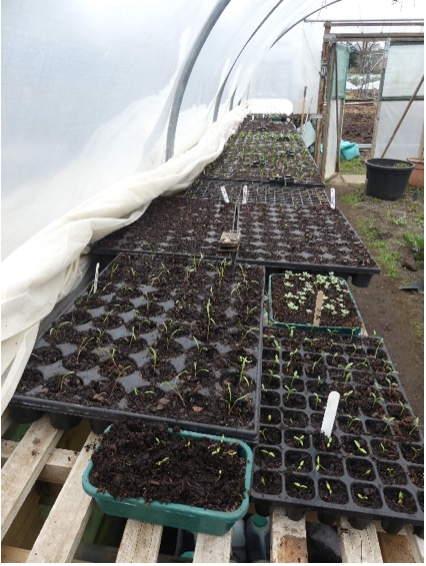
Tomatoes have been potted on. Aubergines and peppers will soon be pricked out, but they have not germinated as well as we had hoped. Summer is approaching and soon it will be time to sow the first courgettes and cucumbers. Many of the plants in the old rhubarb bed were covered with dustbins to force them. As a result we have had a great crop pf pink forced rhubarb. The new fruit area continues to take shape, the cage is in place, the redcurrants are being trained as cordons, and some extra cuttings of gooseberries have been added. We have started the trial bed we are using to grow vegetables for one of the local food banks. First early potatoes have been planted. We expect to add onions and possibly calabrese (broccoli) shortly. Then the plan is to grow vegetables such as runner beans, courgettes, and French beans. It is a first year experiment and I guess we will adapt it in the future dependent on interest and demand. July 2nd our NGS open day still features in everyone’s thought as the year progresses. Will the garden look good and be productive? There are some new photo's in the gallery if you would like to take a look here.
John
MARCH 2023 The winter doesn’t improve. We are experiencing a cold March, and the forecast does not look promising. Many seeds have been sown, most have germinated but there is very little growth as we experience below average temperatures. Thank goodness we only garden for fun, not for a living. The challenges are great. A great deal of work has been done on the area between the old walls where the old glasshouses were sited before we took over. What we find there is mainly broken glass and bindweed. The area is being prepared in order that we can grow some fresh vegetables for a local food bank. The plan is to grow potatoes, beans, and brassicas such as calabrese. 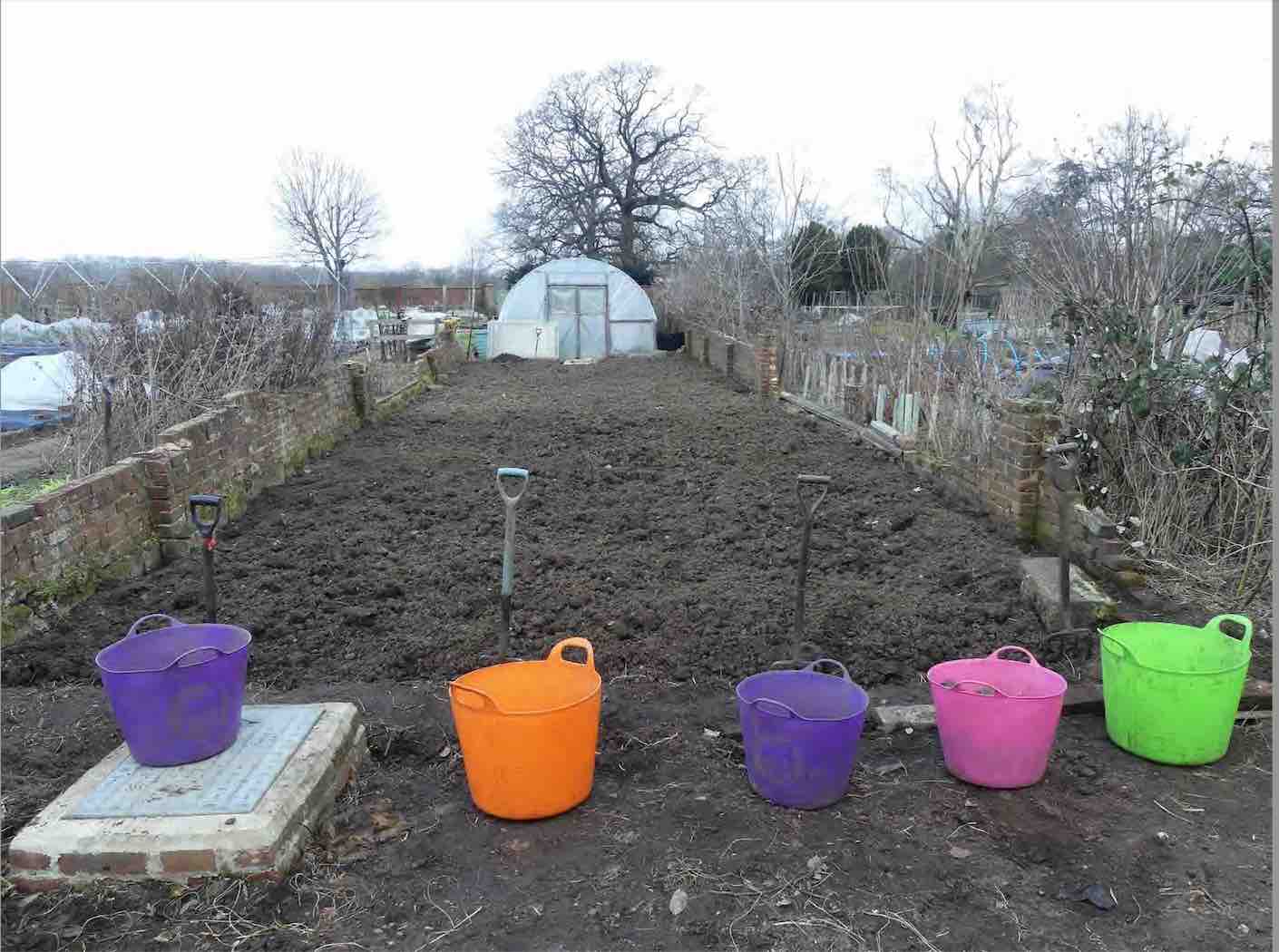
We hope to be planting onions and shallots outside soon and early potatoes at the end of the month. Spinach, turnips, peas, kohl rabi, cabbage, calabrese, cauliflowers, red onions, fennel, dill, coriander, parsley, peas, summer broad beans, radish, and lettuces all of which are showing signs of growth in the polytunnels should be ready to be planted outside under fleece this month too. 
We have ordered enough asparagus crowns to fill another bed. This should add to the crop we get from our two existing beds. It is a really valuable crop in April and May when fresh vegetables are scarce. Autumn broad beans looking good under mesh in the main garden. We are still cropping plenty of leeks, kale, Brussels sprouts, parsnips and some very small cauliflowers. We have just finished the winter cabbages, but they are still plenty of potatoes in store, plus a few garlic bulbs and squash. 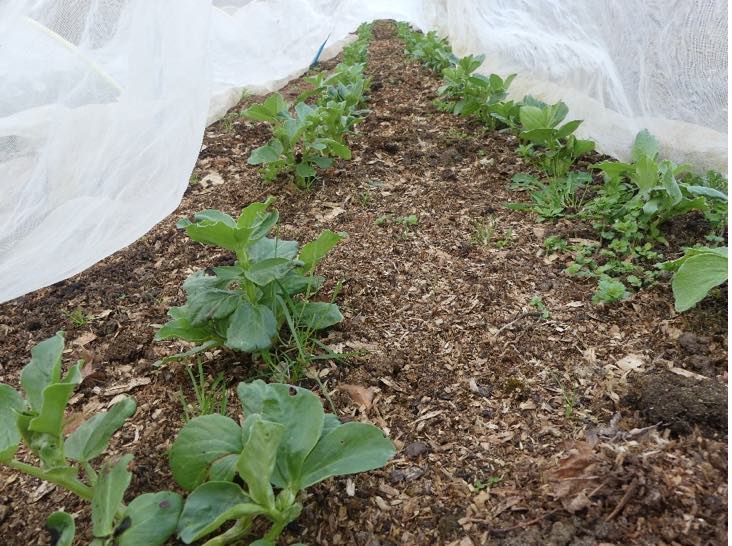
Rhubarb crowns are being forced in the old rhubarb area. The new bed which has good signs of growth will be used for traditional stems. The daffodil bed is giving us with our first cut flowers of the year. There are some new photo's in the gallery if you would like to take a look here.
John FEBRUARY 2023 It has been the most challenging winter we have experienced since the garden began back in 2010. We began with the mildest autumn in living memory. We cropped courgettes in November and autumn raspberries in December. The winter brassicas particularly the savoy and January King cabbages were well (too) advanced. Having had a very hot and dry summer we were hopeful for a mild or at least benign winter. Unfortunately the combination of heavy rains which led to some parts of the garden being extremely wet with lying water, combined with two periods of very low temperatures (at least -80C) has wreaked havoc with some crops. We cut all the winter cabbages early to prevent them splitting as they were becoming very large. However the spring cauliflowers have been severely damaged with at least 40% of the plants having to be removed. We have 3 beds of Purple Sprouting Broccoli which has similarly been decimated. We lost all the over wintering spring onions and the chard too. Some vegetables though are very hardy and appear to have suffered little, such as sprouts, kale, spring cabbages, parsnips, leeks and swede. The autumn sown broad beans outside seem fine but the spares sown in modules in the greenhouse were all frosted. Perhaps the saddest losses have been in the polytunnels which normally give us a massive spring lettuce harvest. The plants have been hit hard by the frost and earlier in the autumn by cutworms. We have some still surviving but less than 30%. The fennel which in recent years have overwintered fine inside, were all destroyed. I am still hopeful the kohl rabi and chard will produce. Mustards and Mizuna are thriving, and herbs such as coriander, parsley and chervil are okay too. It is now February the start of the sowing season weather permitting. Seeds have been bought, potatoes are chitting and the beds have been prepared. The old fruit cage area has been cleared, the new soft fruit beds are looking promising. We are beginning to clear the old asparagus beds which like the old soft fruit area were planted early in the gardens life 10 years ago. They were infested with bindweed, and now the new beds are producing well. The lime trees have had five of them pollarded and more light is streaming into the garden. The daffodils although later than some years are just starting to bud. The NGS garden openings book has arrived. July 2nd is not that far away, let’s hope we have a good year. There are some new photo's in the gallery if you would like to take a look here.
John
SEPTEMBER 2022 Summer has gradually come to an end and the summer crops are almost over. The tomatoes, peppers, runner beans and courgettes have been wonderful. They are still producing but the quantities are reducing weekly. Cucumbers and sweet corn have finished, both accelerated by pests. Red spider mite attacked the cucumbers and the sweet corn seems to have been enjoyed latterly by a whole range of birds and animals. We managed to get some lovely cobs but eventually in came the rats, badgers, magpies, and parakeets. However considering the drought we have produced some fabulous crops including some of the biggest cabbages and cauliflowers to been seen anywhere. I am not a great fan of growing large show vegetables but sometimes it has been difficult to stop them becoming huge. The summer carrots unfortunately have become equally enormous. It is great that after last year’s blight we have been able to grow outdoor tomatoes and potatoes without any issues As we move into our autumn crops, many are already producing. The cauliflowers have been replaced by Romanesco, fennel bulbs are ready, kale both curly and black is abundant, autumn Calabrese heads are forming, lettuce has been augmented with mizuna and mustards, Pak choi has escaped the slugs. There are a number of new crops that will be shortly available. Leeks are ready, members are as usual desperate to start them. They are less keen on the swedes! There are a range of radicchios just about ready to be picked. Turnips are starting to develop, and spinach will be picked this weekend. Whether the Chinese cabbage can succeed without the slugs eating all the leaves is debatable. Sprouts look good but the dry hot summer has been ideal breeding weather for cabbage whitefly. As we don’t use pesticides we will attack them with hose and hands. Having been disappointed by there being virtually no plums this year, we are being compensated by a massive harvest of pears and apples. Apple pressing will start shortly. The quince trees are full of fruit ripening, our treasurer makes great quince cheese/ membrillo. The raspberries and blackberries have also been excellent. The new soft fruit area is getting established and the rhubarb bed looks great for next year. As ever the flowers have kept being sold. It has been a challenging season for everyone, but the bunches of flowers have still looked gorgeous, particularly eye catching have been the China asters and zinnias growing in the main garden. The garden continues to thrive and we have been fortunate to get some great new members this year. The old guard are still working hard but it is great to have an influx of new members some young and some a little older to reinvigorate the group. The other exciting (perhaps a little nerve racking) news is that we expect to be opening to the public as part of the National Gardening Scheme next year. I am sure more information will follow. The early summer has given us the most delicious peas and broad beans. The main crop Alderman peas are tall (5-6ft), which makes picking easy but staking challenging. We appear to have cracked it this year and their long pods have given us gorgeous peas (although by the end of the season a few pea moth caterpillars as well). I wonder if the moths are flying earlier this year. We sowed them on March 2nd which should be early enough to avoid them. The broad beans avoided blackfly and started early and finished late. So far the summer drought has ensured we have avoided any blight which so devastated our potatoes and tomatoes last year. We are growing a whole range of different tomatoes this year, but with plenty of Sungold. They have started producing some delicious tomatoes. We have had vast quantities of cucumbers and courgettes already. Next year less cucumber plants!!! There are some new photo's in the gallery if you would like to take a look here.
John
LATE JULY 2022 As we endure the driest hottest period in our history, somehow the garden is still flourishing. Will it last, there appears to be no rain forecast for at least the next two weeks. Watering has been the number one priority for weeks. The early summer has given us the most delicious peas and broad beans. The main crop Alderman peas are tall (5-6ft), which makes picking easy but staking challenging. We appear to have cracked it this year and their long pods have given us gorgeous peas (although by the end of the season a few pea moth caterpillars as well). I wonder if the moths are flying earlier this year. We sowed them on March 2nd which should be early enough to avoid them. The broad beans avoided blackfly and started early and finished late. So far the summer drought has ensured we have avoided any blight which so devastated our potatoes and tomatoes last year. We are growing a whole range of different tomatoes this year, but with plenty of Sungold. They have started producing some delicious tomatoes. We have had vast quantities of cucumbers and courgettes already. Next year less cucumber plants!!! 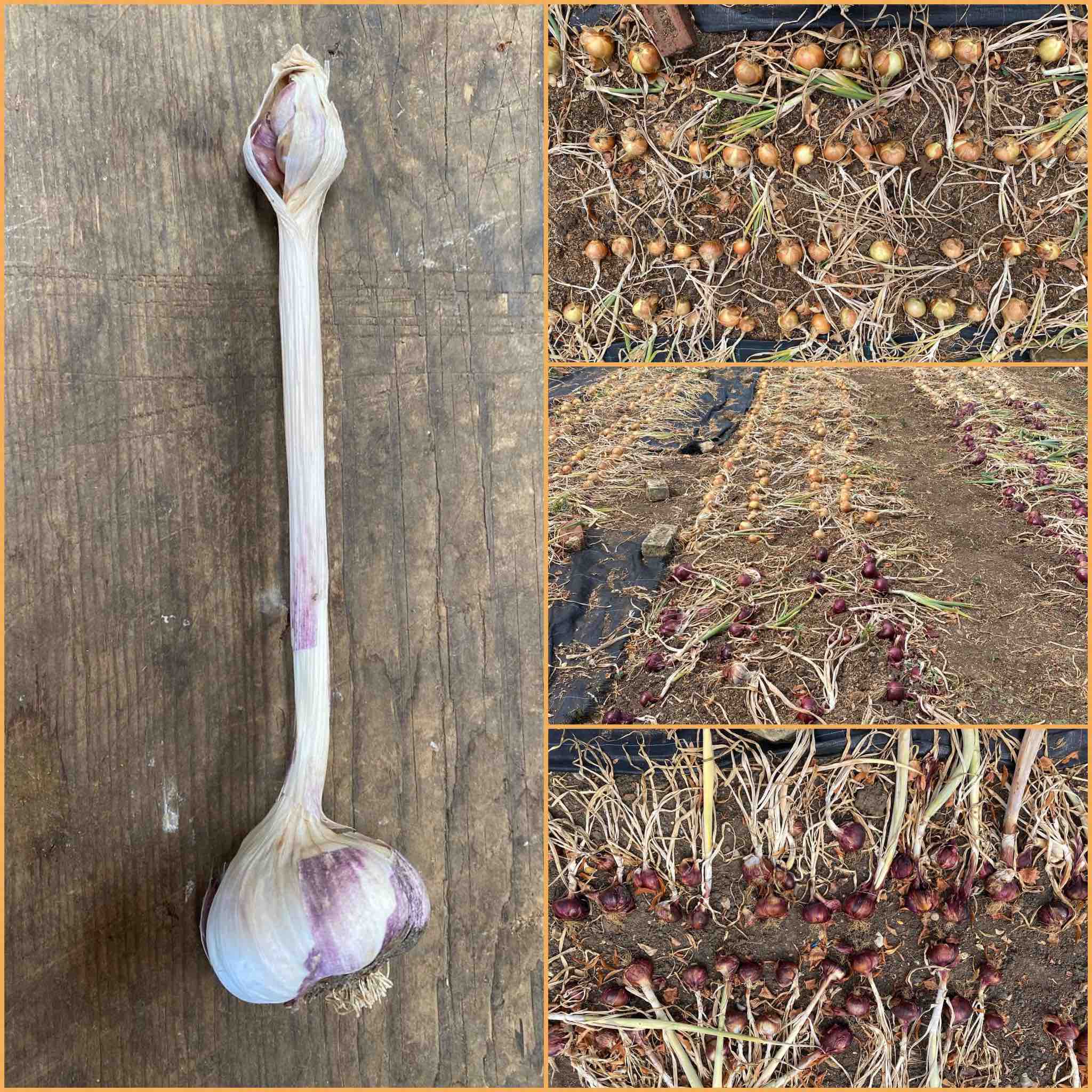 The summer onions have been cropped and have given us an enormous amount of good sized onions. Sadly the autumn planted onions mainly bolted. This has been the case for a couple of years now, so I think it is time to remove those from our planting list. However the garlic planted last autumn from our own saved bulbs have been great.
The summer onions have been cropped and have given us an enormous amount of good sized onions. Sadly the autumn planted onions mainly bolted. This has been the case for a couple of years now, so I think it is time to remove those from our planting list. However the garlic planted last autumn from our own saved bulbs have been great.
Not everything has been perfect, three vegetables have had very poor germination rates. Spring onions were perhaps old seed. We bought celeriac and carrots as pelleted seed for the first time, and both have been terrible. When we sowed normal seed later they germinated without any issues. As ever the brassicas we have planted have been huge. We have massive heads of calabrese, cauliflowers and pointed cabbage. The autumn and winter brassicas are growingly nicely, they should, weather permitting, be equally successful. The main gardening jobs of the year have been completed. Leeks are planted the winter brassicas are growing well. From now it is the more unusual vegetables we sow, such as pak choi, mizunas and mustards. The major task is to dig potatoes without leaving too many in the ground to regrow next year. Will the sweetcorn survive the rats and the badgers? They are developing perfectly…. There are some new photo's in the gallery if you would like to take a look here.
John MAY 2022 The great challenge of gardening in England has continued in May. After a dry April the levels of rainfall have been so low in May that watering has been required on every vegetable we grow. It is made doubly challenging as our water supply only allows a small part of the garden to be watered at one time. The only bonus is that we have had no frosts during the month. If you have been to the garden in recent weeks you will undoubtedly have gone home with a mass of spinach. We have had so much spinach. This helps fill in the ‘hungry gap’. We have 4 beds of spinach, which if put in a line would equal 180 metres of spinach. Until recently we have had some wonderful winter cauliflowers. We have had turnips and kohl rabi (but hardly any members eat these, I love them they make wonderful pickles and are lovely braised). Asparagus has been much better this year, and seems to have coped with the drought. There has been some great herbs to pick, coriander, dill, mint and very soon parsley. We continue outside to have lovely salads including wild rocket. Autumn sown broad beans are earlier than recent years producing lovely beans, unfortunately the mice seem to be enjoying them too. The garden is filling up rapidly with masses of plants and sowings. Cabbages, calabrese and peas should shortly be ready. The early rocket potatoes are in flower. Beetroot maybe picked just at the end of May. Weeding and thinning becomes an issue especially around the direct sown carrots and parsnips. The flower cutting garden that Helena is in charge of in our garden have as ever given us some great flowers for our members. The irises and peonies recently have been stunning. The polytunnel now seems to have an increasing number of modular trays full of summer flowers. Dahlias have been planted, as have many sunflowers and sweet peas. The newly planted soft fruit seems to be flourishing in spite of the lack of rain. We will not be cropping form these this year but the original fruit cage looks to be just about overcoming the dreaded bindweed. Hopefully it might rain in June, but at the moment there is no sign of the significant amount we need. There are some new photo's in the gallery if you would like to take a look here.
John APRIL 2022 We are now ‘full on’ in the garden with plenty of work to do. I guess it will be next year before I say, not sure what we can do today!!! The February polytunnel sowings are being planted. Beds are filling with spinach, peas, broad beans, beetroot, cabbage, cauliflowers, calabrese, kohl rabi, turnips, radish, lettuces and coriander. The first early potatoes are in the ground. Onion sets and seedlings have been planted. The warm days of March really helped. Unfortunately the heavy frost on the first weekend in April wasn’t welcome, and some of the early brassicas got touched by the frost. They should recover. However this is the second year running that we have had a significant frost when the plums and pears are in full blossom!! We experimented with covering one section of the fruit avenue with mesh, I’m not sure how successful it will be, but there was a feeling of helplessness and any attempt to save them was worth it. We still have a number of crops for our members. The purple and white sprouting broccoli have been prolific. We have even taken some surplus to the Cobham Food Bank. Cauliflowers are fabulous. I still get a real pleasure from cutting them, never having grown them successfully until recent years. Leeks are coming to an end but we have had them for 6 months. Rhubarb is being pulled. There is a mass of salad leaves in the polytunnels, and the first spring radishes are ready. We have a few potatoes, garlic and swedes in the store. We look forward to masses of spinach shortly. In addition the first asparagus can be expected soon. The newly planted soft fruit bed is looking good, with all the plants shooting. The rhubarb that we planted is a little mixed, but there is still time for more of the crowns to start producing their first leaves. The original soft fruit bed is now covered over with its netting. We have recently planted peas in some spare space within it. The first daffodils have been giving us bunches for weeks, but have now come to an end. However we can still expect some later in the month from a different part of the garden. There are trays of flower seedlings coming through in the polytunnel. The garden looks wonderful at the moment, I hope we can keep it that way this summer. There are some new photo's in the gallery if you would like to take a look here.
John MARCH 2022 The February winds caused some significant damage to one of the polytunnel’s polythene covers, unfortunately the one that was replaced only a couple of years ago. We have been able to repair it temporarily but it will need to have a new cover before the summer growing season. One of the greenhouses was moved a few cms off its base and a few panes of glass were broken in both of the greenhouses. A poplar tree in the car park came down, but didn’t cause any damage. I guess it could have been worse as it hasn’t affected the vegetable growing. The garden is prepared for the March 2022 season. The beds have been covered with 2.5cms of manure in readiness for the first plantings in the middle of March. The garden looks great for the new season. The first indoor sowings were made in mid –February in the polytunnel and in propagators at home and in one of the member’s new greenhouse (with a heated bench!). Red onions, cauliflowers, cabbage, calabrese, lettuces, radishes, spinach, kohl rabi, turnips, parsley and early peas are already showing. We have also sown at the same time coriander, dill, spring onions and summer broad beans that have yet to germinate. At the beginning of March we have sown peppers, aubergines and more peas. We have sown beetroot, wild rocket and many more peas both traditional and mange- tout. The crops in the garden are still productive. Leeks, Brussels sprouts, parsnips, two types of kale and salad have been available all winter. There are still some potatoes and garlic available. The salad leaves in the polytunnels are now growing and producing well with the increased light levels and warmth. We have begun picking purple sprouting broccoli. There may be a few savoy cabbages to pick soon and hopefully lots of cauliflowers. The new fruit bed has been completely planted, except for one variety of gooseberry which we were unable to source this winter. We have taken cuttings, and will fill in the extra 6 plants next year. In the cutting garden there have been a massive amount of work completed, weeding and cutting back the herbaceous plants. The first daffodils have been prolific, enabling members to buy the first flowers of the season. There are some new photo's in the gallery if you would like to take a look here.
John FEBRUARY 2022 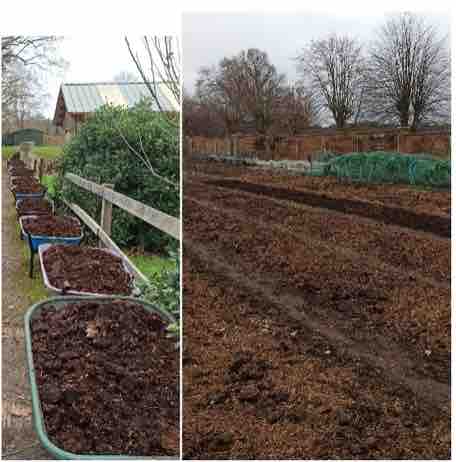
We have spent the winter preparing for the new growing season. The beds which have finished cropping have been cleared and then they have been covered with an inch or so of manure. We have about 80 beds which average in size is about 15m x 1.2m to cover. This requires a great deal of wheelbarrowing but no digging or rotavating. At present I guess we have completed just over 50 of these. We still have some crops for example leeks, kale, swede, parsnips and mixed salad leaves. There are a few vegetables in store, potatoes, squash and garlic. In addition, we hope to have some early spring purple and white sprouting broccoli and cauliflowers coming soon. A newly sited rhubarb bed has been planted with about 45 small crowns. We have bought new crowns and divided some of our old ones. The present rhubarb bed is infested with perennial weeds and the plants have struggled to give us a good crop. They were planted in a south facing position which we have decided would be a better aspect for more sun loving plants such as aubergines and tomatoes. We have a similar if possibly worse problem with our soft fruit cage. This was planted early in the community garden’s history. It is completely over run with bindweed which grows through the plants and the net itself. We are in the process of establishing a new soft fruit garden which we hope will be ready for cropping in 2023. We shall keep the old space for another year to ensure we get a crop this year and then probably move the fruit cage in 2023. It is almost the time to start sowing indoors. We have to consider the conditions at the time but we start off our first seeds around Valentine’s Day 14th February. The majority of the sowings will be placed in our polytunnel or greenhouse without any heat. The goal being to get them ready to plant out during March. The other job we have been busy with is the pruning and tidying the fruit trees, along the avenue, along the wall and in the allotments. There is still some work to do manuring and tidying them before the end of March but a lot of the work has been done already. There are some new photo's in the gallery if you would like to take a look here.
John |
| FIND US | CONTACT US | |
|
Grace & Flavour CIC The Walled Garden Dene Place Ripley Lane West Horsley, Surrey KT24 6JW email: mail@graceandflavour.org 
|
|
|